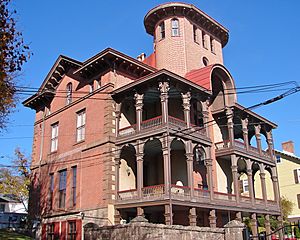Dorrance Mansion facts for kids
Quick facts for kids |
|
|
Dorrance Mansion
|
|
 |
|
| Location | 300 Radcliffe St., Bristol, Pennsylvania |
|---|---|
| Area | 0.4 acres (0.16 ha) |
| Built | 1862 |
| Architectural style | Italianate |
| NRHP reference No. | 86002891 |
| Added to NRHP | October 16, 1986 |
The Dorrance Mansion is a historic house built in 1862-1863 in Bristol, Pennsylvania. It stands on Radcliffe Street, right by the Delaware River. This grand home shows how wealthy people lived in Bristol during the Victorian era. It's known as one of the most impressive houses on the street. It's also the only house in Bristol built in the special Italianate architecture style. The mansion was added to the National Register of Historic Places in 1986, which means it's recognized as an important historical site.
Contents
What Does the Dorrance Mansion Look Like?
The Dorrance Mansion is made of brick and looks almost exactly as it did when it was first built. The front of the house is designed to look very tall. It has windows on the upper floors that get smaller as they go up, creating an interesting visual trick.
One of the most unique parts of the house is its five-story central tower. This tower holds a winding staircase that goes all the way from the basement to the very top. There's also a three-story porch at the back of the house. The original kitchen is in the basement, and a second staircase connects it directly to the dining room. The foundation of the house, which is closest to the river, is made of rough, natural stones.
Who Built the Dorrance Mansion?
The Dorrance Mansion was built for a man named John Dorrance, Sr. He was a very successful businessman in Bristol. Around 1827, he bought a share in the Bristol Mills, and later he owned the whole business. The mills themselves were much older, built in 1701.
John Dorrance, Sr. was involved in many businesses. He was a director for companies that ran steamboats, railroads, and shipping. He also played a part in local government and politics from 1835 to 1860. During this time, his mills sold corn meal to places like the West Indies and the Southern States. John Dorrance, Sr. lived across the street while his grand new mansion was being built on land he bought in 1828.
What Happened to the Mansion After John Dorrance, Sr.?
John Dorrance, Sr. passed away in 1869. After his death, his sons sold the family mills. The mills included many different parts, like a saw mill, a grist mill (which grinds grain), a lumber yard, and even stables for canal boats.
John Dorrance, Sr.'s sons inherited the mansion. His son, John Dorrance, Jr., bought out his brother's share in 1879. Later, John, Jr.'s son, G. Morris Dorrance, inherited the mansion. The Dorrance family owned the mansion until 1921.
After the Dorrance family, the mansion was bought by the Bristol Knights of Columbus. This is a group that does community work. The mansion was used by them for many years. Then, in 1982, the mansion became a private home again.
How Is the Dorrance Family Connected to Campbell Soup?
Another son of John Dorrance, Sr., named Arthur, was an early investor and manager in the Campbell Soup Company. Arthur hired his nephew, John Thompson Dorrance, who was sometimes called John Dorrance III. This nephew was very important because he developed Campbell's famous condensed soup line. In 1915, John Thompson Dorrance became the sole owner of the Campbell Soup Company.
His grandson, also named John Dorrance III, later sold his share of the company in the mid-1990s for a huge amount of money. In 2009, he was listed as one of the richest people in the world by Forbes magazine.




